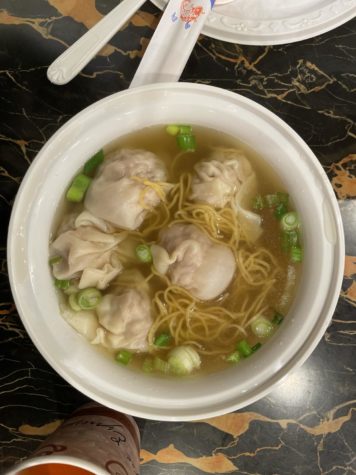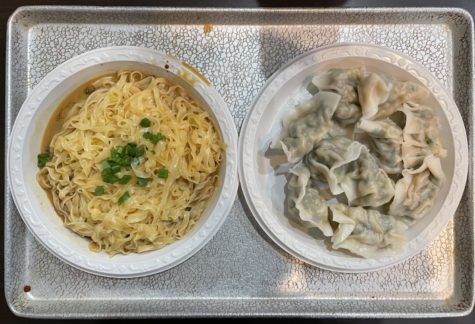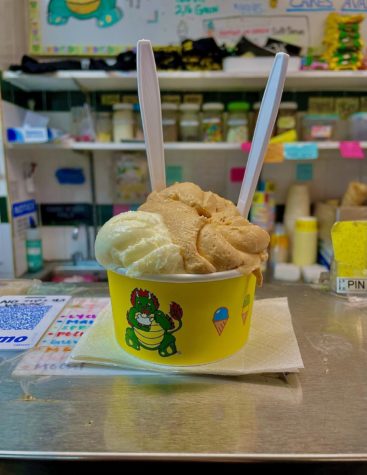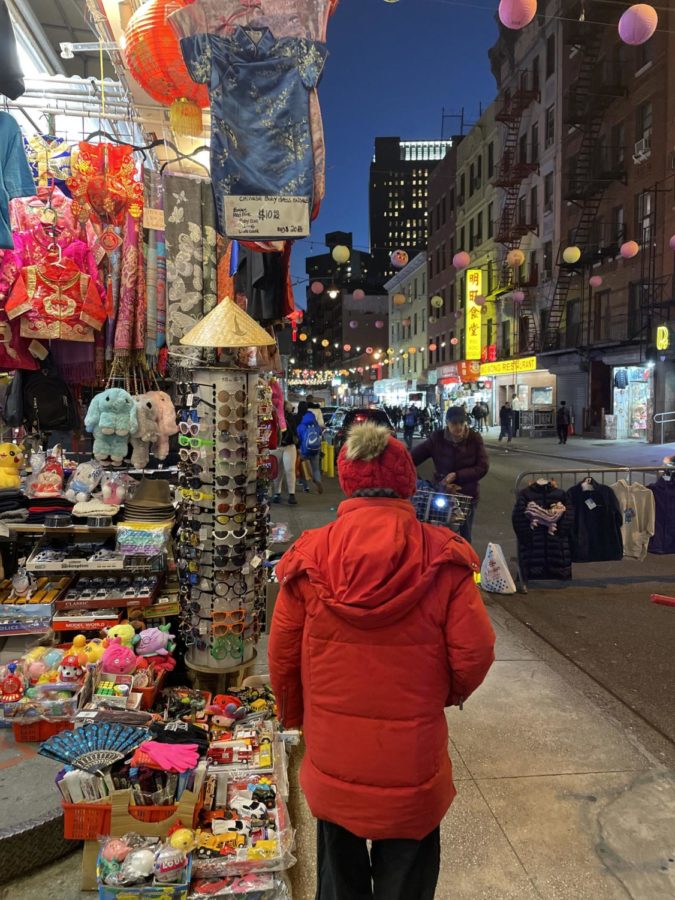An Exploration of the Tastes of Manhattan’s Chinatown
Here’s what to eat in Chinatown, New York’s iconic cultural neighborhood.
Here is one of many gift shops on Mott Street in Manhattan’s Chinatown, under the strings of paper lanterns installed by the Light Up Chinatown project. Due to the Coronavirus pandemic and the rise in sinophobia, many Chinatown businesses and restaurants had been struggling to stay open, so these light fixtures were installed to attract visitors.
Stepping out from the Canal Street station, you are met with the nostalgic rattling of shopping carts and the vibrating notes of a Ruan string instrument. The hasty exchange of various Chinese dialects overlap and fill the street. Sidewalks are lined with fruit stands – hanging bananas, brightly colored piles of sunset mangoes, spiky lychees, magenta dragon fruits, grapes, and apples. You continue your way down Canal Street, stopping at the Mott Street intersection. Hanging over you is a faintly flashing “Welcome to Chinatown!” sign, assembled in cursive and surrounded by thin snowflakes.
Following the Gold Rush and the construction of the First transcontinental railroad, a New York City gem emerged. In the late 1800s, Chinese immigrants fled eastward, seeking an escape from severe anti-Chinese sentiments in the West. They settled in what is now the “heart” of Chinatown-Mott, Pell, and Doyers Street.
Chinatown’s cuisine dates back to early tea houses, dim sum parlors, and rice shops, serving mostly Chinese customers. However, these eateries were soon westernized to cater to American tastes, creating the unique Chinese-American palate. Today, over 200 restaurants fill the narrow streets with centuries worth of timeless dishes waiting to satisfy all your cravings.
Wonton Noodle Garden: 56 Mott St, New York, NY 10013

(Katelyn Chiao )
Coined as the unofficial “main street,” Mott Street is arguably the center of Chinatown’s hustle and bustle. Recently installed pink, yellow, and orange lanterns sway above your head. The block is lined with countless authentic Chinese restaurants, bakeries, gift and jewelry shops.
Under the inviting glow of these paper lanterns, Wonton Noodle Garden is located at the corner of Mott and Bayard Street. Just a glance at the restaurant will reveal workers boiling noodles, dumplings, wontons and fish balls behind a steamy glass window. At times, lines of roasted Peking ducks are also displayed. Hanging from multiple bars, the ducks entice customers who notice their crisp, glossy, amber-brown skin.
Workers are dressed in burnt orange colored button-ups, similar to a modernized version of the traditional Tang-Zhuang. The color of the shirts reflect the warm ambiance of the restaurant. “The friendly staff create a welcoming and comfortable experience, offering smiles and jokes along with the food,” said Sidney Lin ’25.
For over 30 years, the neighborhood restaurant has offered a variety of familiar Cantonese dishes, namely the comforting wonton noodle soup. The wontons are a must try, their soft, thin skin plump with shrimp and minced pork. This sensation is paired with warm broth and a choice of either thin or thick chewy egg noodles. For Lin, a bowl of wonton noodle soup at this spot has been a family tradition since her childhood. “The flavorful wonton dumplings, paired with chewy noodles and warm broth will always take me back to weekend lunches as a kid.”
Rice Noodle Cart: 153 Centre St, New York, NY 10013
Located on Centre Street, just a block from the Canal Street subway station, this small food cart offers affordable Cantonese street food. Rice Noodle Cart is only open from the morning to mid-afternoon, making it the perfect option for a quick breakfast on-the-go or a satisfying afternoon snack. It had been closed for a year due to the Covid-19 pandemic, but has reopened since May of 2021, to the excitement of many Chinatown residents.
As its name suggests, the food cart is well known for its steamed rice noodles, topped with either fish balls or pork skin. At the price of just four dollars, the soft and chewy rice noodles are submerged in a perfect mixture of soy sauce, hot sauce, hoisin and sesame seeds. The menu also offers other comfort foods such as congee, chow may fun (pan fried vermicelli noodles), and tea eggs. “The owner of the rice noodle kart on 153 Centre Street has been selling rice noodles with fish balls and tea eggs for decades. It’s a food vendor that I visited often during my childhood,” said Vanessa Wu ’25.
Shu Jiao Fu Zhou: 295 Grand St, New York, NY 10002

Groups of people sit on wobbly chairs and mismatched tables, huddled over Styrofoam plates of steaming food. This humble cash-only eatery offers authentic, flavorful Fuzhounese dishes at a notably low price. These affordable dishes range from $3.00 to $5.50. Unlike typical restaurants, where a server is responsible for your table, you order at the cashier before choosing a seat. Behind the cashier, chefs are pulling noodles and dumplings from vats of boiling water. I ordered dishes and the employee repeated them, shouting over clanging pots and pans to the chefs. As I was walking away to look for a table – less than a minute after ordering- the employee called me back, handing me a tray filled generously with dumplings and noodles.
After biting into the thin, chewy skin of the hand-wrapped dumplings, the ground pork and chive filling is introduced with a burst of juice and flavor. A plate of six dumplings costs $3.00, while a plate of ten costs $4.50. The three dollar peanut butter noodles were made with wheat noodles and a peanut butter concoction. This sauce had a perfect balance of light and rich flavors, the overwhelming peanut butter calmed with other ingredients such as sesame oil and soy sauce. The long and flat noodles were soft and chewy, creating an exceptionally satisfying experience. A sprinkle of chopped scallion added a pleasant spring to the plate.
Chinatown Ice Cream Factory: 65 Bayard St, New York, NY 10013
11:00 AM – 10:00 PM, Fri – Sat
Even on the coldest days of New York’s harsh winters, customers line up on Bayard Street, waiting for their scoop of Chinatown’s famous ice cream. Peeking out from behind the eager crowd is a bright poster of a smiling green dragon enjoying his own cup of the frozen dessert.
The family-owned Chinatown Ice Cream Factory (CICF) has been serving creamy, traditional Chinese flavored ice cream with colorful twists since 1978. However, it had not always been the iconic “unofficial New York landmark” it is now. Founder Philip Seid had originally opened a café, but its failure led to the beginnings of a frozen wonderland. After 45 years, the shop has withstood the test of time and is now a second-generation owned business. “We represent an old Chinatown and are an integral part of the community,” said Christina Seid, who is the daughter of Mr.Seid and CICF’s current owner.

Entering the store, less than five employees work behind a glass counter displaying over 40 flavors of ice cream. The rainbow array of creamy perfections is not the only innovative thing about Chinatown Ice Cream Factory. In fact, one of their most notable creations is the menu itself, which is separated into regular flavors, exotic flavors and special appearances. Asian inspired flavors such as Black Sesame, Durian, Red Bean, Ginger, Lychee and Taro are labeled as “regular,” while American staples such as Chocolate, Vanilla and Rocky Road are labeled as “exotic.” Many customers find this quite amusing, often snapping photos of the oddity.
CICF’s ice cream servings are especially generous. Therefore, I would recommend only choosing one or two flavors, although the extensive selection makes this a difficult task. Nevertheless, the vast amount of unique options provide the perfect opportunity to try something outside your comfort zone, whether that be a “regular” or “exotic” flavor. Vivien Lu ‘25 decided on a scoop of Thai Iced Tea ice cream from the “regular” menu. “The bright colors of the ice cream and even the Chinatown Ice Cream Factory shop itself really just draw you right in. The Thai iced tea is my favorite flavor. Its thick and velvety texture melted into the balanced sweetness of a homemade glass of Thai iced tea,” Lu said. When I asked for Ms. Seid’s favorite flavors this winter, she recommended “pumpkin pie and almond cookies, which are cozy flavors.”
In light of the Covid-19 pandemic and the relentless xenophobia that followed, it is especially important to support Chinatown’s restaurants and businesses. Despite numerous difficulties in the last three years, Chinatown’s culinary community continues to flourish, offering one of the most divine experiences in New York City. The warmth and joy in every bite you take in Chinatown is a true testament to the tight-knit community that keeps its spirited culture alive.
Despite numerous difficulties in the last three years, Chinatown’s culinary community continues to flourish, offering one of the most divine experiences in New York City. The warmth and joy in every bite you take in Chinatown is a true testament to the tight-knit community that keeps its spirited culture alive.
Katelyn Chiao is an Arts and Entertainment Editor and Social Media Editor for ‘The Science Survey.' She finds that journalism is especially fascinating...











